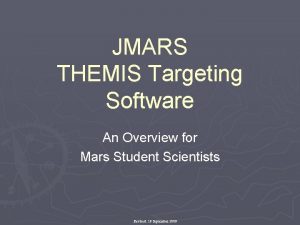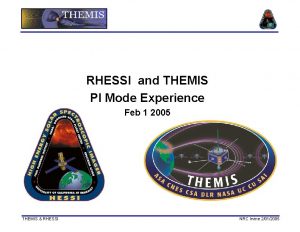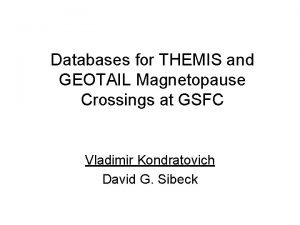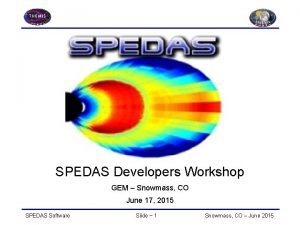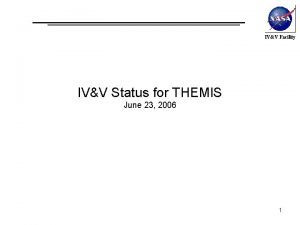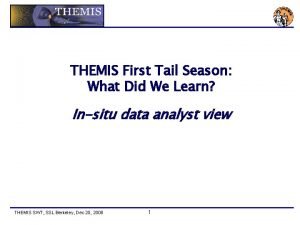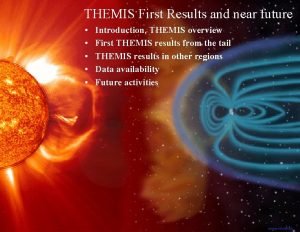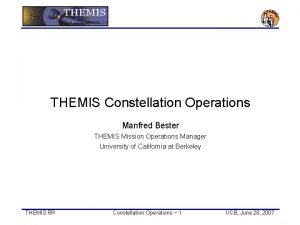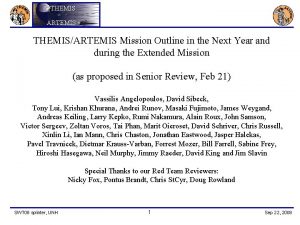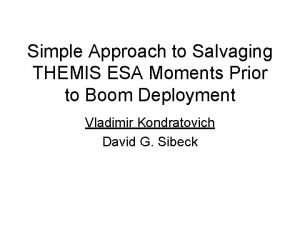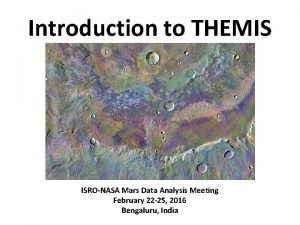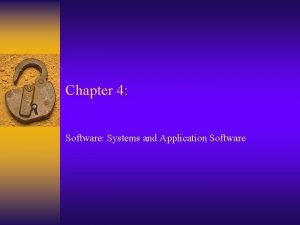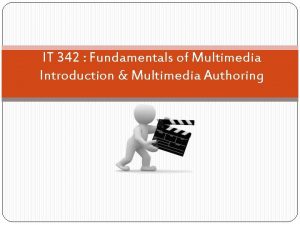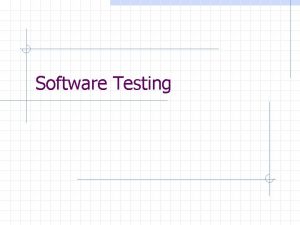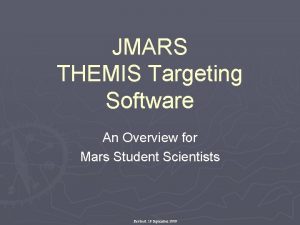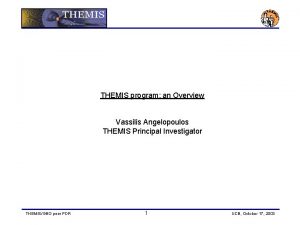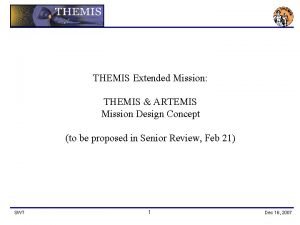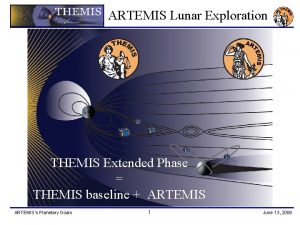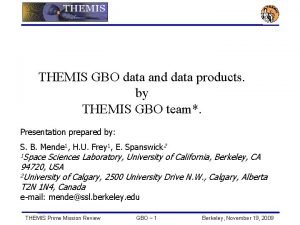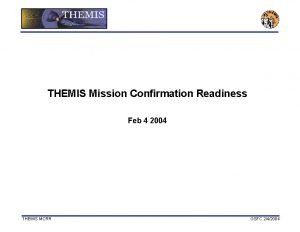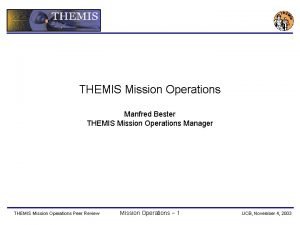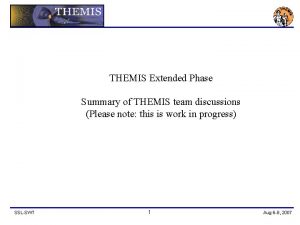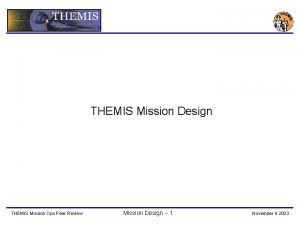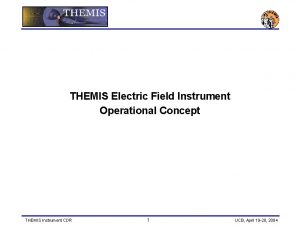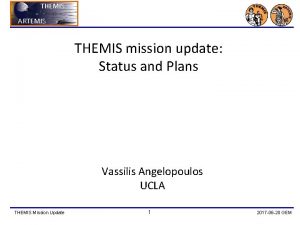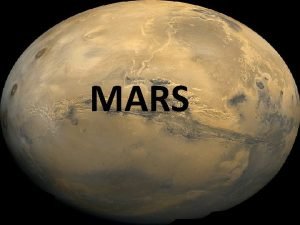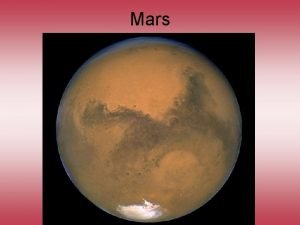JMARS THEMIS Targeting Software An Overview for Mars






























- Slides: 30

JMARS THEMIS Targeting Software An Overview for Mars Student Scientists Revised: 19 September 2006

Overview of Topics Covered } Part I: Looking at JMARS § JMARS views and windows § JMARS features } Part II: Looking at Mars § Moving around in JMARS § Recording the location of possible targets } Part III: Targeting an Image § Creating an observation § Recording important numbers 2

Part I Looking at JMARS

Looking at JMARS Get familiar with the JMARS software and its features: § JMARS views and windows § JMARS features 4

Open JMARS } If you are running JMARS directly from the CD (FYI - This is the easiest way to use JMARS), double click on the studentjmars. jar file and give the program a few minutes to open. It will open to the ET provided on the label of your CD: } If you installed the contents of the JMARS CD on your computer, at the MS-DOS prompt (X: >, where X is the hard drive letter in which you installed JMARS), type: java -jar studentjmars. jar ##### } ##### is the 9 -digit Ephemeris Time (ET) § ET is the starting time index of the day § ET = Number of seconds since midnight January 1, 2000 § This number is provided on the label of the CD-ROM 5

JMARS Windows } Layer Manager window § Used to add and adjust data layers § Not used much by MSIP students § *IMPORTANT* for each time you open up JMARS - Click on the line of words that says ‘Themis obs. ’ so that the blue rectangular box is around those words. This will allow you to add an observation later } JMARS View window § Shows the data layers in two different views § Focus on this 6

JMARS View Window } Two views § Planet view § Map view (enlarged view of the red box in planet view) } Odyssey orbit track § Lines in center of each view are predicted ground track of the THEMIS camera § Red: infrared camera track (32 km wide) § Green: visible camera track (18 km wide) 7

The MOLA Dataset } Shaded relief map (shown here) is made up of data from the Mars Orbiter Laser Altimeter (MOLA). } The latest version of JMARS has the colorized MOLA topography § Blues and purples = low elevations § Reds, browns, and whites = higher elevations } When starting up, there is no data to the left (this may look like a blue and red checkerboard) § This is the beginning of the day’s orbits 8

Displaying Solar Incidence } A black and yellow area should appear at the bottom of the view window § This is called the MLT/SIA Ruler 9

Displaying Solar Incidence } If the MLT/SIA Ruler does not automatically appear, right-click in the map view window and check “Mars Local Time/ Solar Incident Ruler” 10

The MLT/SIA Ruler Blue lines: Solar Incidence Angle (SIA) } Red lines: Mars Local Time (MLT) } You are on the day side of Mars when both red and blue lines are in yellow (day) region } § Visible images must be taken during the day! 11

Part II Looking at Mars

Looking at Mars § How to move around the planet in JMARS § Listing important information about possible targets 13

Navigating in JMARS } To move: Left-click on the orbit lines in the planet view § This will re-center the planet view and map view on the clicked location } Allow time for program to redraw § This may take a minute or longer } Beginning of the day’s orbits: No data to the left § Scroll to the right to see the rest of the day’s orbits (Note: there are 12 orbits in one day) Click within the orbital predict lines in the planet view to navigate in JMARS and show the predicted orbit of Odyssey around Mars 14

Zooming the Map View } Zoom Factor can be changed in upper right corner § Numbers are pixels per degree } Zoom Factor of 64 is useful § Higher zooms show bigger pixels, not more 15

Important Numbers } Ephemeris Time (ET) § ET at top of view window is ET at center of map view § ET below planet view is ET at mouse location } Lat/Lon below planet view are at mouse location 16

When a Feature Fits Your Research Question } Is feature within the GREEN predicted orbit lines? } Is it during the day? } Make sure the mouse is over the feature within the predicted orbit lines and record the Lat/Lon from the bottom line § IMPORTANT: Latitude restrictions change with the seasons. Current latitude restrictions are 85 N to 0 N (September 2006) } Record the ET from the top line 17

When a Feature Fits Your Research Question 18

Make a List } Scroll through the predicted orbital track § As you go, record ET and lat/lon of each interesting feature } When you are done, re-visit each target § Type in the target ET in the top left field to jump to that location } Select and prioritize the two best targets that fit your question § Discuss and debate your choice with your fellow scientists! 19

Part III Targeting an Image

Targeting an Image § Creating an observation § Recording important numbers 21

Creating an Observation } Enter the target’s ET in the top left field } Note: Look at the Layer Manager window and make sure you clicked on the line of words (NOT the tab) that says ‘Themis Observation’ (see page 6 instructions). } On the JMARS window rightclick on map view (or for MACs hold down the apple key and click the mouse) § Choose “Add Observation”, then “Add Two Minute Observation” } The cursor becomes a faint cross 22

Placing the Observation } Click on the predicted orbit track in map view to show observation stamp } Click again to place or move observation stamp onto desired target } Click one more time to select the observation stamp 23

The Observation Stamp } Red area is infrared image § Not used by most MSIP teams } Gray box inside red area is visible image § You are targeting this image § Faint gray lines are boundaries between framelets § There will be about 19 framelets in this one-band image 24

Moving the Observation } Drag the red area to move the visible observation onto the feature to target } Visible image target is ~18 km by ~57 km 25

Recording Important Numbers } Place mouse cursor in the middle of the visible observation } Record from tooltip (shown in purple): § Visible (VIS) ET § Lat/Lon from below Note: The tooltip will disappear after a few seconds. Move your mouse and the tooltip will reappear. 26

Recording Important Numbers } Move the mouse straight down from the observation to the MLT/SIA ruler } Record from tooltip: § Mars Local Time (MLT) § Solar Incident Angle (SIA) 27

And Finally… } Write a short description of the features seen within the THEMIS visible camera target } Capture the target to a JPEG by selecting “Capture to JPEG” from the “File” menu (This is optional. If you are able to do this, please print the jpeg to turn in with your target request. ) } Use the JMARS target form to fill in the requested information and submit the form (and jpeg if you have one) to your instructor by the deadline date. 28

Summary of Information for THEMIS Mission Planners } } } Start ET (VIS) Lat/Lon Mars Local time Solar Incidence Angle Written description of target JPEG image of observation (if possible) Please use the JMARS sheets provided to indicate this information for mission planners. You need to get this information to your instructor by the deadline date indicated. 29

CONGRATULATIONS!!! You have targeted your own THEMIS visible image!
 Themis software
Themis software Isvc login
Isvc login Themis fm
Themis fm Themis pi
Themis pi Themis lenguaje inclusivo
Themis lenguaje inclusivo Themis athanassiadou
Themis athanassiadou Themis
Themis Themis dc
Themis dc Spedas wiki
Spedas wiki Themis
Themis Themis
Themis Themis
Themis Themis constellation
Themis constellation Artemis
Artemis Themis
Themis Themis athanassiadou
Themis athanassiadou Themis competition
Themis competition Esa themis
Esa themis Mars data analysis software
Mars data analysis software Logic based testing in software testing
Logic based testing in software testing Personal application software
Personal application software Cpmcd full form
Cpmcd full form It 342
It 342 Definition of software testing
Definition of software testing Algori
Algori Fspos
Fspos Novell typiska drag
Novell typiska drag Nationell inriktning för artificiell intelligens
Nationell inriktning för artificiell intelligens Vad står k.r.å.k.a.n för
Vad står k.r.å.k.a.n för Varför kallas perioden 1918-1939 för mellankrigstiden
Varför kallas perioden 1918-1939 för mellankrigstiden En lathund för arbete med kontinuitetshantering
En lathund för arbete med kontinuitetshantering
